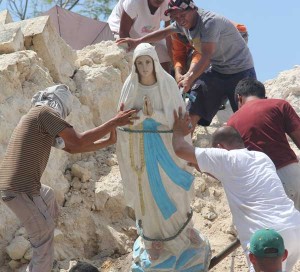THE government will need at least P750 million to repair and rebuild public infrastructure damaged by the powerful earthquake that shook Central Visayas last week, according to the National Disaster Risk Reduction and Management Council (NDRRMC).
The 7.5 temblor destroyed roads, bridges, buildings and private property worth at least P2.5 billion, the disaster agency said, noting that the figure was a conservative estimate.
NDRRMC Executive Director Eduardo del Rosario on Sunday said at least P750 million will be needed for infrastructure alone, based on the initial assessment of the Department of Public Works and Highways (DPWH) and the Department of Social Welfare and Development (DSWD).
The NDRRMC placed damage to infrastructure in Bohol, the hardest hit province, at P655 million, P96 million in Cebu, P7.3 million in Siquijor and P250,000 in Negros Oriental.
Del Rosario said the residents also suffered substantial losses.
“With regards to damaged private houses it will be substantial also because thousands were damaged,” he said.
Of the 8,480 houses that were destroyed, 8,464 were in Bohol.
If damage to each house was placed at P50,000, del Rosario said the total will reach P1.79 billion.
“So we can just imagine the magnitude of the damage to the private sector and this is the main reason why the displaced persons need tarpaulins, family tents because they are sleeping outside,” he said.
The earthquake affected 703,244 families or 3,542,281 persons in Cebu, Bohol, Siquijor, Negros Oriental, Iloilo and Guimaras
As of early yesterday, 185 bodies have been recovered and nine persons are missing.
Del Rosario said another challenge facing officials is bringing relief goods to villages where roads remain impassable.
“The way I’ve seen it, in the last two days that I was there, the relief supplies are adequate. The problem is the distribution to remote barangays after they were turned over to the local government units,” he added.
He said the Air Force will fly relief supplies to hard-to-reach areas.
The government will also give P10,000 in assistance to the families of those who died and P5,000 for the injured starting on Tuesday.
The money, he said, will be handed out by the Office of Civil Defense, where del Rosario also sits as chairman, upon presentation of a death certificate or a certificate of confinement.
Malacañang also announced on Sunday that the Philippine Health Insurance Corp. (PhilHealth) will cover all the hospital expenses of quake victims.
Presidential deputy spokesman Abigail Valte said PhilHealth will cover for the hospitalization and outpatient surgical treatment and procedures to the victims.
Valte said relief operations are continuing with the distribution of food and non-food relief goods worth P8.05 million to the victims.
The DSWD, she said, is coordinating with the local government units especially those in isolated areas delivering relief goods.
“The relief operations will continue until normalcy returns to all towns in Bohol and Cebu,” Valte said.
She said 55,769 families, or 257,268 people staying in evacuation centers in Bohol and Cebu are being served.
The rescue team sent by Vice President Jejomar Binay to Loboc dug up two bodies in Barangay Villaflor.
Binay said the team also checked a dam that sustained quake damage.
“The rescue team will assess the integrity of the dam and see if people living within its vicinity need to evacuate. We don’t want to take chances. We want to ensure they are safe,” he said.
A team from Makati City, together with personnel from the Manila Water and the National Disaster Risk Reduction and Management Council, is producing 2,000 liters of potable water per hour for the victims through Makati’s water filtration system.
WITH REPORTS FROM CATHERINE S. VALENTE AND RITCHIE A. HORARIO


